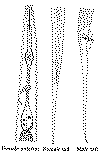
|
Refer to subfamily diagnosis (Tylodorinae)
- Body slender, 0.4-1.0 mm long
- Cuticle striated with 4 to 6 lateral incisures.
- Head offset by a constricyion, Amphid apertures elongate
slits.Stylet generally long for the family, but short in some
species, with distinct knobs.
- Metacorpus oval.
- Postcorpus generally butting or slightly overlapping intestine,
but with a longer overlap in C. driekieae.
- Tail long, filiform.
Fenale:
- Monodelphic, prodelphic
- Vulva often bordered with lateral membranes
- Postvulval sac longer than body width.
Male:
|